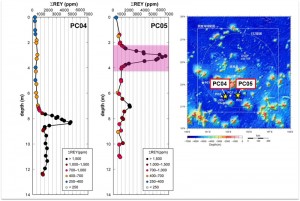Discovery of rare earths around Minami-Torishima Highly concentrated REY-rich mud just below seafloor

Rare-earth elements and yttrium (REY) are crucial elements for novel electronic equipment and green-energy technologies, and world demand for them is rapidly increasing. However, 97% of the world’s production of REY is accounted for by China, and export restrictions and price controls of REY by China have become a serious problem. For Japan, securing of stable and reliable supply sources of REY is an urgent issue.

© JAMSTEC and Kato Lab. Depth profiles of ΣREY contents in piston cores around Minami-Torishima. Very highly concentrated (6,600ppm) rare earth deposits were found just three meters below the surface at PC05.
Professor Yasuhiro Kato and his research team conducted a research cruise to collect deep-sea mud in the Exclusive Economic Zone (EEZ) around Minami-Torishima, 1,900 km southeast of Tokyo, in collaboration with the Japan Agency for Marine-Earth Science and Technology (JAMSTEC) using the deep-sea research vessel “Kairei” in January 2013 (KR13-02 Cruise). They obtained seven deep-sea mud core samples from the seafloor of 5,600 to 5,800 meters below sea level, and carried out chemical analysis of the mud to investigate the distribution of REY near the seafloor.
Analytical results show that the maximum REY content in the mud reaches 6,600 ppm, which is 20 to 30 times higher than that of ion-absorption-type deposits in southern China. Professor Kato’s team also found that the extremely concentrated REY-rich mud layer is located only a few meters below the seafloor. Moreover, it has been revealed that critical information on depth distribution and thickness of REY-rich mud can be easily obtained by sub-bottom profiler (SBP) on shipboard.
These results are expected to provide important scientific knowledge leading to understanding the formation mechanism, REY resource potential, and spatial distribution of REY-rich mud around Minami-Torishima, and to open a vista for the future of Japan as a resource-rich nation.
Related materials
Yasuhiro Kato, Koichiro Fujinaga, Kentaro Nakamura, Yutaro Takaya, Kenichi Kitamura, Junichiro Ohta, Ryuichi Toda, Takuya Nakashima & Hikaru Iwamori,
“Deep-sea mud in the Pacific Ocean as a potential resource for rare-earth elements”,
Nature Geoscience 4, 535?539 (2011) doi: 10.1038/ngeo1185.
Related article link
Links
Graduate School of Engineering
Frontier Research Center for Energy and Resources, Graduate School of Engineering
Kato Lab, Frontier Research Center for Energy and Resources, Graduate School of Engineering






